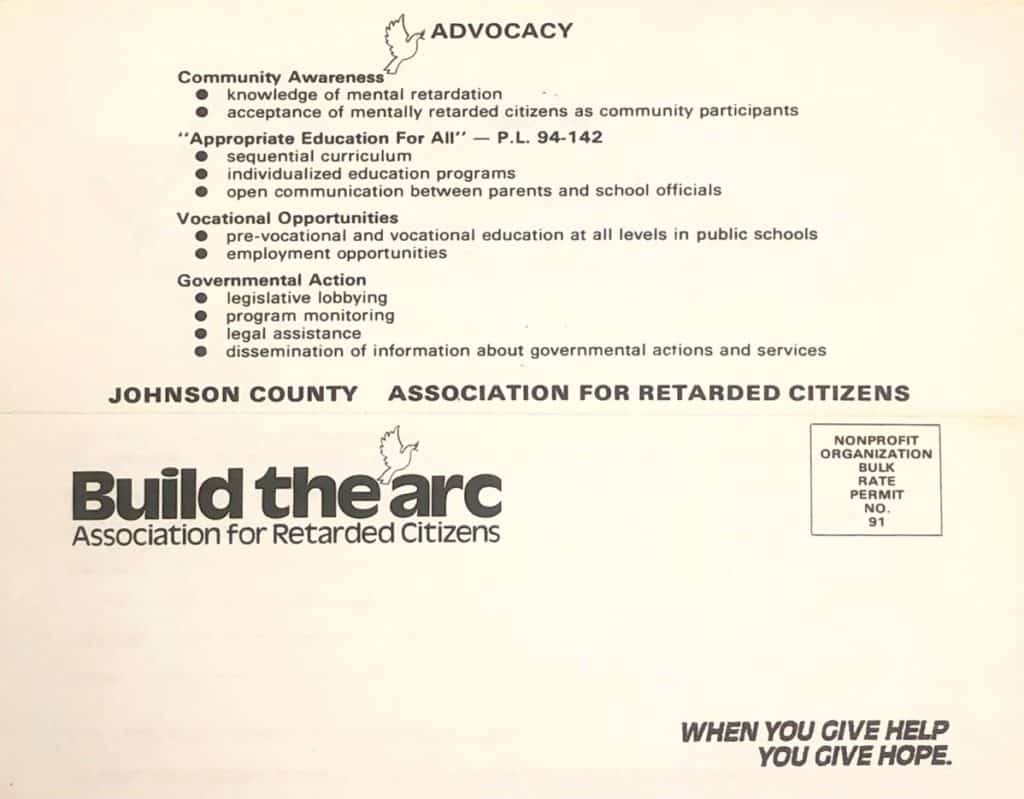The following post was written by IWA Student Specialist, Abbie Steuhm.
In the process of creating a LibGuide on women and disability for the Iowa Women’s Archives (IWA), I discovered a trove of artifacts from disabled women and disability advocates. However, this did not come easy as the history was hidden by its description.
I began my process by simply locating finding aids with the words “disability, disabled, disabilities,” etc. This yielded a handful of sources about disabled women and disability advocates from around the seventies and eighties, but not much more than that. However, I came across an idea when I read through the finding aid of Elizabeth D. Riesz. One folder in Riesz’s collection was titled “Johnson County Association of Retarded Citizens,” which made me realize that I was using the wrong language in my search. By using the outdated language listed by the National Center on Disability and Journalism, I pulled in significantly more sources than in previous searches.

While I was able to discover more sources, a new problem emerged. These collections use outdated and inaccurate language to describe disabled people, making them not only harder to find but also perpetuating harmful stereotypes. Many archives and libraries are reanalyzing their collection descriptions in what is called “reparative description.” Archivists like Annalisa Moretti from Harvard’s Houghton Library have been incorporating disability studies into their descriptions to replace harmful language and bring out hidden disability history. Using Moretti’s and other archivists’ experience and disability studies, I embarked on a reparative description project in the IWA.
The organization from Elizabeth D. Riesz’s collection was found in several other collections, such as the Ruth Salzmann Becker papers. I began by researching the Johnson County Association, finding that they renamed themselves to the Arc of Southeast Iowa. On the organization’s website, they state that they “stopped recognizing the acronym ARC or ‘Association of Retarded Citizens’” to take on “a descriptive meaning for ‘The Arc’…representing a bridge in services.”
Knowing this, I changed the folder title in Riesz’s collection from “Johnson County Association of Retarded Citizens” to “Arc of Southeast Iowa.” This way the harmful language is removed, and researchers coming from Arc can discover Riesz’s collection. I did the same process with the Greenberg Family papers and the Welch and Angrick papers. Both these collections included folders titled “Polk County Society for Crippled Children and Adults,” and my research found that the organization took on their early nickname “easter seals” as their new name becoming “Easterseals Iowa.”
Not every collection had a simple solution. When I came across the “Blosser Home for Crippled Children” name in the Marie Tener Havel papers, I found that building would later become a women’s home, leaving behind its previous occupation. Since there is no modern alternative to this name, my only choice is to leave it as is. If I were to change the name of the home, then I would be erasing its history as a home for children with disabilities. This case showed how we cannot change every word in these descriptions, and that the words we use in descriptions now hold weight.

Another instance of this issue occurring was with the Judy Herron Hoit papers. Hoit was a pageant winner, wheelchair user, and disability advocate. One of her most notable achievements was winning the Handicapped Woman of Iowa Pageant in 1991. The term “handicapped” is currently being replaced with “disabled” and other disability-specific terms. However, like in Marie Tener Havel’s collection, the pageant was a one-of-a-kind event that is no longer held. To preserve history, the name itself must remain as is.
My reparative description project allowed me to make significant changes to the IWA’s collections, as well as bring to light some forgotten disability history. It also revealed the issue of repairing names and titles that use harmful and outdated language. While we cannot change every description, we can encourage the use of modern language and disability studies to our researchers so that they know how to properly describe disability history. As archivists, we should also continue our work in reparative description and do our own research on how to properly describe various topics without relying on our biased assumptions. This way, we try to prevent the harm caused by inappropriate description.

